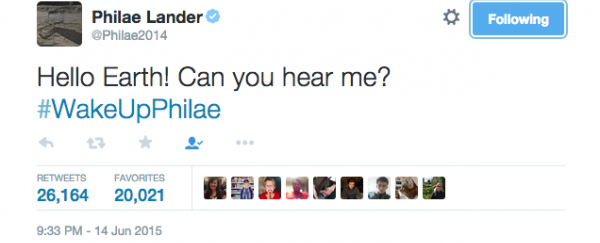After about seven months of silence, a probe that landed on a comet back in November has finally woken up and established communication with the spacecraft orbiting the comet.
The European Space Agency (ESA) made history when it became the first to send a spacecraft into orbit around a comet in November, 2014. ESA's Rosetta spacecraft then attempted to land a probe called Philae on the surface of the comet.
But ESA lost contact with Philae when it landed on the comet too hard, bounced high into the air twice, and landed in the shadows under an outcrop of the comet.
Philae operates on solar power, so with no sunlight shining on it, it went into hibernation mode.
It was able to get about 60 hours of work done before shutting off, but scientists were worried that was all it would be able to do, since it had landed in a shady area of the comet, unable to get enough sun to recharge its batteries. It took close up photos of the comet and surface samples before powering down.
All ESA scientists could do was wait and hope that the comet would turn toward the sun enough that Philae could charge up her batteries.
Early in the morning on June 14, (late afternoon on June 14 European time) Philae's social media team sent a message after they heard from the probe:
Hello Earth! Can you hear me? #WakeUpPhilae
— Philae Lander (@Philae2014) June 14, 2015
The data from Philae shows the probe has been awake for a while, but just now got charged up enough to beam a message.
The probe is designed to take samples and map the surface of the comet, but Philae can't get back to work right away. ESA scientists need to double check all its instruments and make sure everything is running smoothly:
.@Philae2014 Need to check you’re fit, healthy and warm enough first @philae2014! Take it easy for now :)
— ESA Rosetta Mission (@ESA_Rosetta) June 14, 2015
The initial data looks promising though, according to ESA.
"Philae is doing very well: It has an operating temperature of -35ºC and has 24 Watts available," Philae Project Manager Stephan Ulamec said in a press release. "The lander is ready for operations."
ESA will post more information as it becomes available, but it looks like we'll get to learn a lot more about Rosetta's comet.
The data from Philae may help scientists figure out exactly what went wrong with the landing and where on the comet Philae ended up.
More from Business Insider:
